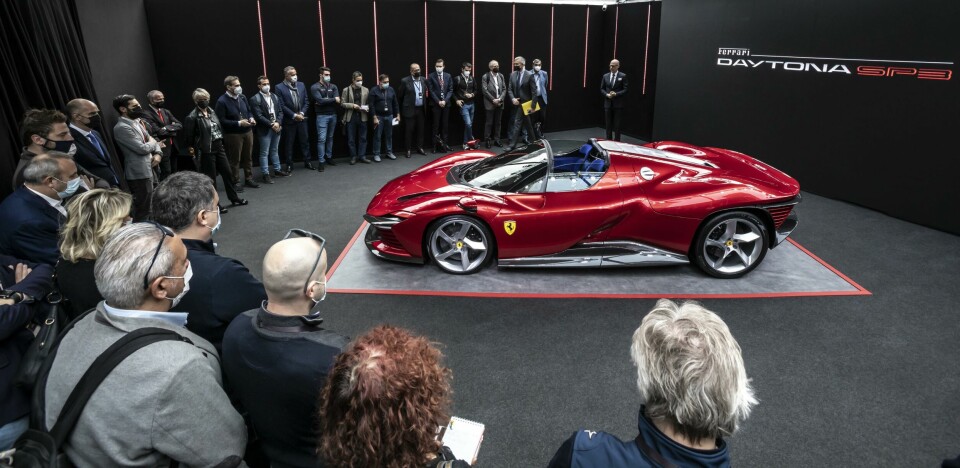
Ferrari Daytona SP3 lead by purity of design
Ferrari has revealed its Daytona SP3, the latest in its exclusive series of Icona models
When Ferrari announced it was going to make the third in its series of Icona models, many expected it to follow the theme of a collector’s car in the same vein as the Monza SP1 and SP2. Those were roadsters that lacked a windscreen, meaning they could not be sold in many parts of the world. Even so, all were sold out and Maranello got to work on the third iteration.
Back to basics
It is nothing like its predecessors and by all accounts is in stark contrast to the strategy of electrification that Ferrari is embarking on. Instead, the new Daytona SP3 is a more analogue, back-to-basics performance car that has been inspired by the great Ferrari endurance sports prototypes of the 1950s and 60s.
The main inspiration is the famous 330 P3/4 that gave Ferrari its revenge victory over Ford by heading a 1-2-3 finish for Maranello at the 24 Hours of Daytona in 1967. It is that race that has also given the Daytona SP3 its name, but it is the 330 P3/4 that has provided many of the key design points.
Like the SP1 and SP2, the lead for the Icona series cars was given to the design department, headed up by Flavio Manzoni. This too is in contrast to Ferrari’s usual approach, which is to start with the driver, then develop the engineering and finally to hand it all over to design to work on.
Manzoni says that no specific car provided the inspiration for the Daytona SP3, stating instead that the overarching theme was of the Sport Prototype series of cars from the era of the 330 P3/4. However, there are clear similarities, from the aero-flicks either side of the front apron to the wraparound windscreen, butterfly doors and the horizontal strakes that span the rear.
A slice of drama
The same is true of the voluptuous fenders, which Manzoni says add drama to the volume and are part of dramatic and expressive shapes evident throughout the design. The lines flow organically, creating tension between the front and rear he told us, part of a return to simple aerodynamics. This is also a key differentiation with the supercar, with Ferrari choosing not to follow the path of active aerodynamics. Instead it is the function of the design and its integration with the engineering that creates the downforce of up to 230kg.
This includes the fixed, wide rear spoiler, which features a narrow aperture through which air is used not for typical aerodynamics, but to suck away some of the 350-degrees Celsius heat from the exhaust. Without it, the heat would melt the rear lights above. Those lights sit between the blades that Manzoni says create the appearance of a solid, monolithic object.
The cabin is also a more simple affair. The seats nestle inside a carbon fibre tub from the LaFerrari Aperta, which also provided the chassis for the Daytona SP3. They are bolted directly to the tub and feature a design that incorporates both the seats and the armrest to create what Manzoni refers to as a layout almost like a sofa. There’s a simple wraparound theme to the IP too, with the only real sign of technology being the Human Machine Interface digital instrument cluster. Emanuele Corrando, head of product marketing at Ferrari, told us that they did consider going right back to analogue instruments to follow the back-to-basics theme, but decided that owners are used to this digital layout now and besides, they can personalise it be as complex or simple as they wish.
There is one final significant piece of design that cannot go unnoticed. Legislation has put paid to the era of pop-up headlights, but Manzoni says he and the engineering team have managed to achieve something fairly close. The upper portion of the headlights is covered by a panel that slides way when the high beams are engaged. It doesn’t quite have the drama of pop-ups but it’s a unique touch and one that Manzoni is very proud of.
Purity
Just 599 examples will be produced with a price tag of around €2-million. All have been sold, with the first 499 being allocated to those who bought a Monza SP1 or SP2. The other 100 were offered to those who were unable to own a Monza due to regulations relating to the lack of a windscreen.
While the performance of the naturally aspirated V12 with its 840hp and 0-62mph time of 2.85 seconds will grab much of the attention for many, to us it is the design that sparks conversation. Manzoni says that the “purity of the car has been the main driver,” which is not something that we hear so often these days. It is remarkably refreshing to see design lead on a project such as the Daytona SP3, especially in this era of technology. In a car that has been engineered so much around a more analogue driving experience, it is perhaps even more remarkable.

















